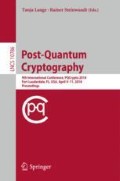Abstract
The HFEv- signature scheme is one of the most studied multivariate schemes and one of the major candidates for the upcoming standardization of post-quantum digital signature schemes. In this paper, we propose three new attack strategies against HFEv-, each of them using the idea of projection. Especially our third attack is very effective and is, for some parameter sets, the most efficient known attack against HFEv-. Furthermore, our attack requires much less memory than direct and rank attacks. By our work, we therefore give new insights in the security of the HFEv- signature scheme and restrictions for the parameter choice of a possible future standardized HFEv- instance.
The rights of this work are transferred to the extent transferable according to title 17 § 105 U.S.C.
Access this chapter
Tax calculation will be finalised at checkout
Purchases are for personal use only
References
Kipnis, A., Patarin, J., Goubin, L.: Unbalanced oil and vinegar signature schemes. In: Stern, J. (ed.) EUROCRYPT 1999. LNCS, vol. 1592, pp. 206–222. Springer, Heidelberg (1999). https://doi.org/10.1007/3-540-48910-X_15
Ding, J., Schmidt, D.: Rainbow, a new multivariable polynomial signature scheme. In: Ioannidis, J., Keromytis, A., Yung, M. (eds.) ACNS 2005. LNCS, vol. 3531, pp. 164–175. Springer, Heidelberg (2005). https://doi.org/10.1007/11496137_12
Patarin, J., Courtois, N., Goubin, L.: QUARTZ, 128-bit long digital signatures. In: Naccache, D. (ed.) CT-RSA 2001. LNCS, vol. 2020, pp. 282–297. Springer, Heidelberg (2001). https://doi.org/10.1007/3-540-45353-9_21
Bettale, L., Faugère, J.C., Perret, L.: Hybrid approach for solving multivariate systems over finite fields. J. Math. Cryptol. 3, 177–197 (2009)
Garey, M.R., Johnson, D.S.: Computers and Intractability: A Guide to the Theory of NP-Completeness. W. H. Freeman & Co., New York (1979)
Patarin, J.: Hidden Fields Equations (HFE) and Isomorphisms of Polynomials (IP): two new families of asymmetric algorithms. In: Maurer, U. (ed.) EUROCRYPT 1996. LNCS, vol. 1070, pp. 33–48. Springer, Heidelberg (1996). https://doi.org/10.1007/3-540-68339-9_4
Faugère, J.-C., Joux, A.: Algebraic cryptanalysis of Hidden Field Equation (HFE) cryptosystems using Gröbner bases. In: Boneh, D. (ed.) CRYPTO 2003. LNCS, vol. 2729, pp. 44–60. Springer, Heidelberg (2003). https://doi.org/10.1007/978-3-540-45146-4_3
Kipnis, A., Shamir, A.: Cryptanalysis of the HFE public key cryptosystem by relinearization. In: Wiener, M. (ed.) CRYPTO 1999. LNCS, vol. 1666, pp. 19–30. Springer, Heidelberg (1999). https://doi.org/10.1007/3-540-48405-1_2
Courtois, N., Klimov, A., Patarin, J., Shamir, A.: Efficient algorithms for solving overdefined systems of multivariate polynomial equations. In: Preneel, B. (ed.) EUROCRYPT 2000. LNCS, vol. 1807, pp. 392–407. Springer, Heidelberg (2000). https://doi.org/10.1007/3-540-45539-6_27
Faugere, J.C.: A new efficient algorithm for computing Gröbner bases (F4). J. Pure Appl. Algebra 139, 61–88 (1999)
Faugere, J.C.: A new efficient algorithm for computing Gröbner bases without reduction to zero (f5). In: ISSAC 2002, pp. 75–83. ACM Press (2002)
Mohamed, M.S.E., Ding, J., Buchmann, J.: Towards algebraic cryptanalysis of HFE challenge 2. In: Kim, T., Adeli, H., Robles, R.J., Balitanas, M. (eds.) ISA 2011. CCIS, vol. 200, pp. 123–131. Springer, Heidelberg (2011). https://doi.org/10.1007/978-3-642-23141-4_12
Ding, J., Hodges, T.J.: Inverting HFE systems is quasi-polynomial for all fields. In: Rogaway, P. (ed.) CRYPTO 2011. LNCS, vol. 6841, pp. 724–742. Springer, Heidelberg (2011). https://doi.org/10.1007/978-3-642-22792-9_41
Ding, J., Kleinjung, T.: Degree of regularity for HFE-. IACR Cryptology ePrint Archive 2011, 570 (2011)
Ding, J., Yang, B.-Y.: Degree of regularity for HFEv and HFEv-. In: Gaborit, P. (ed.) PQCrypto 2013. LNCS, vol. 7932, pp. 52–66. Springer, Heidelberg (2013). https://doi.org/10.1007/978-3-642-38616-9_4
Bettale, L., Faugère, J., Perret, L.: Cryptanalysis of HFE, multi-HFE and variants for odd and even characteristic. Des. Codes Cryptogr. 69, 1–52 (2013)
Porras, J., Baena, J., Ding, J.: ZHFE, a new multivariate public key encryption scheme. In: Mosca, M. (ed.) PQCrypto 2014. LNCS, vol. 8772, pp. 229–245. Springer, Cham (2014). https://doi.org/10.1007/978-3-319-11659-4_14
Cabarcas, D., Smith-Tone, D., Verbel, J.A.: Key recovery attack for ZHFE. [22], pp. 289–308 (2017). https://doi.org/10.1007/978-3-319-59879-6_17
Vates, J., Smith-Tone, D.: Key recovery attack for all parameters of HFE-. [22], pp. 272–288 (2017). https://doi.org/10.1007/978-3-319-59879-6_16
Petzoldt, A.: On the complexity of the hybrid approach on HFEv-. Cryptology ePrint Archive, Report 2017/1135 (2017). https://eprint.iacr.org/2017/1135
Yang, B.-Y., Chen, J.-M.: Theoretical analysis of XL over small fields. In: Wang, H., Pieprzyk, J., Varadharajan, V. (eds.) ACISP 2004. LNCS, vol. 3108, pp. 277–288. Springer, Heidelberg (2004). https://doi.org/10.1007/978-3-540-27800-9_24
Lange, T., Takagi, T. (eds.): PQCrypto 2017. LNCS, vol. 10346. Springer, Cham (2017). https://doi.org/10.1007/978-3-319-59879-6
Acknowledgements
We thank the anonymous reviewers of PQCrypto for their valuable comments which helped to improve this paper. In particular we want to thank the shepherd for her help in creating the final version of this paper.
Author information
Authors and Affiliations
Corresponding author
Editor information
Editors and Affiliations
Rights and permissions
Copyright information
© 2018 Springer International Publishing AG, part of Springer Nature (outside the US)
About this paper
Cite this paper
Ding, J., Perlner, R., Petzoldt, A., Smith-Tone, D. (2018). Improved Cryptanalysis of HFEv- via Projection. In: Lange, T., Steinwandt, R. (eds) Post-Quantum Cryptography. PQCrypto 2018. Lecture Notes in Computer Science(), vol 10786. Springer, Cham. https://doi.org/10.1007/978-3-319-79063-3_18
Download citation
DOI: https://doi.org/10.1007/978-3-319-79063-3_18
Published:
Publisher Name: Springer, Cham
Print ISBN: 978-3-319-79062-6
Online ISBN: 978-3-319-79063-3
eBook Packages: Computer ScienceComputer Science (R0)

